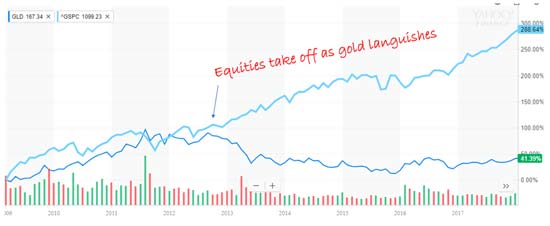I'm frequently asked about gold.
Over the years, it's been a great investment, but lately… (sigh).
Let's just say the shiny stuff has hardly lived up to expectations.
Part of that is due to the dynamics of the gold market itself, and part of that is due to the fascination with cryptocurrencies.
Let's talk about each of those things then move onto a great way – perhaps even the only way – to play gold today.
Gold has historically been driven by its relationship to inflationary expectations, to interest rates, and to physical supply. Generally speaking, gold prices move inversely to economic prosperity.
You can actually see that quite clearly when you compare the SPDR Gold Shares ETF (NYSE:GLD) to the S&P 500. Prices tracked almost in tandem from 2009 to mid-2012, then broke when investors finally decided that the post financial crisis recovery had teeth.

Now, with geopolitical concerns rising and interest rates on the uptick, many investors are wondering if gold could "shine" again.
I wouldn't bet on it.
As of last November, The Wall Street Journal reported that retail gold sales were at the lowest levels in a decade. Mohamed El-Erian, chief economic advisor to Allianz (DE:ALVG) SE (ETR: ALV), even went so far as to warn that cryptocurrencies could pose a serious long-term threat to gold.
My sentiments exactly.
The situation is so bad that even gold purchasers buying directly from the U.S. Mint are reportedly getting pinched as dealers stockpile coins they can't sell. Sales volumes have dropped off a cliff.
There's simply not a lot of buyers, nor are there likely to be. But that doesn't mean all is lost.
You can still profit from gold if you know where to look and which tactics to use.
Playing Gold in "Pairs" for Profits
My suggestion is to play gold with something called a "pairs" trade.
If you've never heard the term before, a "pairs" trade means that you are simultaneously buying and selling shares of two different companies and treating the net spread between them as a single position.
Practically speaking, it's no different than ordering a "value meal" at your favorite fast food joint. You're paying one price for a burger, fries, and a drink.
Pairs trades have a number of advantages that make them ideal for current market conditions. They offer:
- Big profit potential no matter which direction the markets go next
- Easy implementation
- Minimal risk exposure
Pairs trading has been around since roughly the early 1980s, when Morgan Stanley (NYSE:MS) quants figured out that they could trade the markets for huge profits using an investing approach that did not depend on market direction.
Since then, pairs trading has become widely used by institutional traders, proprietary trading desks, and even individual investors thanks, in large part, to the Internet.
The idea is simple.
Traders use either fundamental or technical data to construct a pairs trade based on highly correlated stocks, indices, or other instruments. Usually they're in the same sectors or industries, but that's not always the case.
When done correctly, pairs trades are delta-neutral (meaning they don't depend on direction), inexpensive to put on (because the short help pay for the long), and limited risk (because they're dollar-sized instead of being share-dependent).
Pairs trades are also optionable, which means that traders who want more juice or who desire using smaller amounts of capital can still be successful. For example, a trader could sell calls on the stronger security while selling puts against the weaker. As both revert to their statistical mean, the trader profits from time decay and price movement.
There's plenty of verifiable third-party evidence that pairs trading is profitable.
One of the most important is the 1998 paper from the Yale School of Management by Evan Gatev, William Goetzmann, and Geert Rouwenhorst. One of the better, more clearly written, books on the subject, if you'd like a more in-depth understanding, is Pairs Trading: Quantitative Methods and Analysis by Ganapathy Vidyamurthy.
The premise is straight forward.
